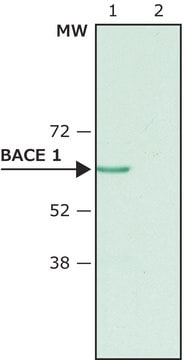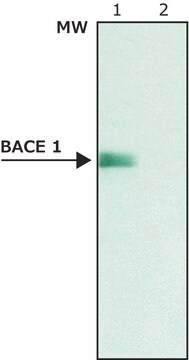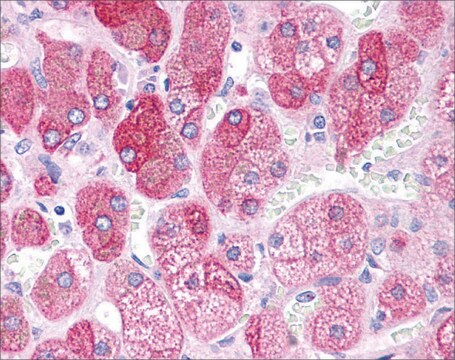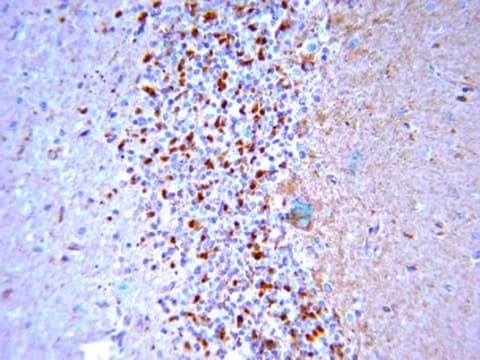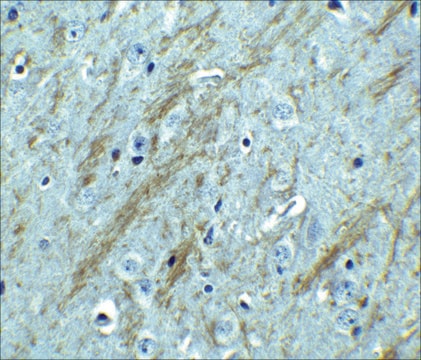MAB5308
Anti-BACE Antibody, CT, clone 61-3E7
clone 61-3E7, Chemicon®, from mouse
Sinónimos:
ASP2, BACE1, Beta Secretase, beta-Site APP Cleaving Enzyme
About This Item
Productos recomendados
origen biológico
mouse
Nivel de calidad
forma del anticuerpo
purified immunoglobulin
tipo de anticuerpo
primary antibodies
clon
61-3E7, monoclonal
reactividad de especies
primate, mouse, human, rat
fabricante / nombre comercial
Chemicon®
técnicas
immunoprecipitation (IP): suitable
western blot: suitable
isotipo
IgG1
Nº de acceso NCBI
Nº de acceso UniProt
Condiciones de envío
wet ice
modificación del objetivo postraduccional
unmodified
Información sobre el gen
human ... BACE1(23621)
Descripción general
BACE is an N-glycosylated integral membrane aspartyl protease with Mr=70 kDa. Mature BACE is produced from the immature form through a series of post-translational proteolytic cleavages and glycosylation. Sequence analysis has revealed that the immature form of BACE contains an N-terminal signal sequence (residues 1-21) followed by a large catalytic domain, a single transmembrane domain (residues 461-477), and a short cytoplasmic domain (residues 478-501). The signal sequence (1-21) is cleaved from the immature form by a signal peptidase located in the endoplasmic reticulum (ER), yielding the proBACE protein (Mr=75 kDa) which starts at residue 22. The proBACE protein is modified by cleavage of 24 N-terminal residues (aa 22-45), producing the mature BACE protein.
Especificidad
Inmunógeno
Aplicación
Neuroscience
Neurodegenerative Diseases
Immunohistochemistry on paraformaldehyde fixed tissues from human, rat, mouse and monkey.
Immunocytochemistry on cells expressing BACE. Acetone or methanol fixation preferred; 4% PFA 5′, RT followed by 0.1% triton X-100 1 hour, can also be used. 1:200-1:500 is recommended, optimization is necessary.
Immunoprecipitation:
Optimal working dilutions must be determined by end user.
Descripción de destino
Forma física
Almacenamiento y estabilidad
Nota de análisis
Brain
Otras notas
Información legal
Cláusula de descargo de responsabilidad
Not finding the right product?
Try our Herramienta de selección de productos.
Código de clase de almacenamiento
10 - Combustible liquids
Clase de riesgo para el agua (WGK)
WGK 2
Punto de inflamabilidad (°F)
Not applicable
Punto de inflamabilidad (°C)
Not applicable
Certificados de análisis (COA)
Busque Certificados de análisis (COA) introduciendo el número de lote del producto. Los números de lote se encuentran en la etiqueta del producto después de las palabras «Lot» o «Batch»
¿Ya tiene este producto?
Encuentre la documentación para los productos que ha comprado recientemente en la Biblioteca de documentos.
Nuestro equipo de científicos tiene experiencia en todas las áreas de investigación: Ciencias de la vida, Ciencia de los materiales, Síntesis química, Cromatografía, Analítica y muchas otras.
Póngase en contacto con el Servicio técnico